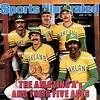Gopher_In_NYC
Well-known member
- Joined
- Apr 19, 2010
- Messages
- 24,035
- Reaction score
- 16,727
- Points
- 113
TRIVIA
Following a (correct) scoring change, Alex Kirilloff ended up with a triple in a third consecutive game with his RBI knock into the right-field corner on Saturday. Four other Twins had accomplished that feat -- most recently, Eddie Rosario. Who was the first to do it?
A) Tony Oliva
B) Rod Carew
C) Brant Alyea
D) Jacque Jones
Following a (correct) scoring change, Alex Kirilloff ended up with a triple in a third consecutive game with his RBI knock into the right-field corner on Saturday. Four other Twins had accomplished that feat -- most recently, Eddie Rosario. Who was the first to do it?
A) Tony Oliva
B) Rod Carew
C) Brant Alyea
D) Jacque Jones


